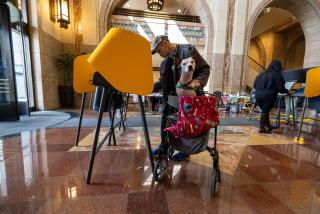Editorial: End California’s election madness
- Share via
It hardly seems possible, but in less than two weeks there will be another election in Los Angeles.
Local elections have been occurring with unusual frequency in 2017 for neighborhoods in the city’s eastern regions. An Oct. 3 vote in a special election to fill a single Assembly seat will be the fifth since March. It will very likely be followed by a sixth vote on Dec. 5, assuming none of the 13 lesser-known candidates running on Oct. 3 gets more than 50% of the total.
For the record:
4:40 p.m. Oct. 2, 2017This editorial incorrectly reported some of the details of a voter-approved change in Los Angeles city elections. The change will take effect in 2020, not 2018, and city elections will coincide both with state and national primaries in June and with general elections in November.
Six trips to the polls (or the mailbox, for the growing percentage of the electorate that mails in ballots) in just nine months are far too many to expect from even the most steadfast voters. But there’s no way to avoid this overabundance of democracy unless lawmakers change the state’s elections law to give the governor more flexibility to hold seats open longer or fill them more quickly when offices are vacated midterm.
There’s nothing special about an election that’s decided by a tiny fraction of the voters.
The cavalcade of elections was set in motion when Sen. Barbara Boxer (D-Calif.) announced in 2015 that she would leave Congress when her term expired at the beginning of 2017. She’s certainly not to blame for what followed. In fact, Boxer deserves credit for giving early warning of her intent not to run again, because it allowed potential contenders sufficient time to ramp up a serious campaign. If only every senator from this state were as forthcoming about their plans for the future (ahem, Sen. Dianne Feinstein, ahem).
Voters chose state Atty. Gen. Kamala Harris to replace Boxer, and Gov. Jerry Brown moved quickly to replace Harris with Rep. Xavier Becerra (D-Los Angeles). That left a vacancy in the House of Representatives, at which point a cascade of elections became all but inevitable.
State law lays out a strict timeline that the governor must follow when filling vacancies in the U.S. House and the Legislature. A special election must be announced within two weeks and held within 126 to140 days, unless there is a regularly scheduled election occurring sooner or immediately afterward.
To make a long story somewhat shorter, neither the initial special election for Becerra’s seat, which was held in April, nor the runoff in June could be consolidated with the two regularly scheduled city elections in March and May because the timing was a little bit off. To compound the election excess, Assemblyman Jimmy Gomez (D-Eagle Rock) ultimately won the special election, prompting another special election to fill his seat.
And here we are, with more elections than is reasonable in less than a year. If history is any guide, less than 15% of registered voters will bother to turn in a ballot on Oct. 3. The lower the turnout, the more the outcome is likely to be swayed by the special interests and campaign donors who already wield outsize influence in state politics. A healthy democracy depends on engaged voters, and too many elections is one sure way to turn them off. That is a big reason that Angelenos, at least the ones who vote, chose to move local elections to coincide with the state and national ones held in November, starting in 2018.
Whoever ends up winning the special election for Assembly District 51 will owe their victory, at least in part, to the flawed state elections code, and thus has a duty to help fix it. Rather than mandating special elections within 140 days, legislators should give the governor more flexibility to consolidate trips to the ballot box — for example, by enabling the governor to appoint a temporary caretaker for state legislative seats or to leave a seat vacant until the next regularly scheduled election. After all, there’s nothing special about an election that’s decided by a tiny fraction of the voters.
Follow the Opinion section on Twitter @latimesopinion and Facebook
More to Read
A cure for the common opinion
Get thought-provoking perspectives with our weekly newsletter.
You may occasionally receive promotional content from the Los Angeles Times.










